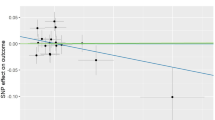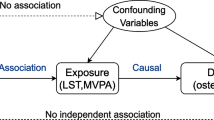Abstract
Background
Observational studies suggest that physical activity (PA) can independently modify the risk of developing multiple sclerosis (MS).
Objective
To investigate the causal effect of PA on MS by Mendelian randomization (MR) approaches.
Methods
Through a genome-wide association study including 91,105 participants from UK Biobank, we obtained 5 single-nucleotide polymorphisms (SNPs) associated with accelerometer-measured PA (P < 5 × 10−8). Summary-level data for MS were obtained from a meta-analysis, incorporating 14,802 subjects with MS and 26,703 healthy controls of European ancestry. MR analyses were performed using the inverse-variance-weighted method, weighted median estimator, and MR-PRESSO method. Additional analyses were further performed using MR-Egger intercept and Cochran’s Q statistic to verify the robustness of our findings.
Results
We failed to detect a causal effect of PA on MS (OR, 0.60; 95% confidence interval [CI], 0.30–1.20; P = 0.15) per in the random-effects IVW analysis. Additional MR methods yielded consistent results. MR-Egger regression suggested no evidence of horizontal pleiotropy (Intercept = 0.14, P = 0.21) and there seemed no substantial heterogeneity (I2 = 29.8%, P = 0.22) among individual SNPs.
Conclusion
Our findings suggest that enhancing PA might not modify the risk of developing MS independent of established risk factors.


Similar content being viewed by others
References
Goldenberg MM (2012) Multiple sclerosis review. P T 37(3):175–184
Reich DS, Lucchinetti CF, Calabresi PA (2018) Multiple sclerosis. N Engl J Med 378(2):169–180
Lo J, Chan L, Flynn S (2020) A systematic review of the incidence, prevalence, costs, and activity/work limitations of amputation, osteoarthritis, rheumatoid arthritis, back pain, multiple sclerosis, spinal cord injury, stroke, and traumatic brain injury in the United States: A 2019 Update. Arch Phys Med Rehabil. https://doi.org/10.1016/j.apmr.2020.04.001
Noonan CW, Williamson DM, Henry JP, Indian R, Lynch SG, Neuberger JS, Schiffer R, Trottier J, Wagner L, Marrie RA (2010) The prevalence of multiple sclerosis in 3 US communities. Prev Chronic Dis 7(1):A12
Nocon M, Hiemann T, Müller-Riemenschneider F, Thalau F, Roll S, Willich SN (2008) Association of physical activity with all-cause and cardiovascular mortality: a systematic review and meta-analysis. Eur J Cardiovasc Prev Rehabil 15(3):239–246
Warburton DE, Nicol CW, Bredin SS (2006) Health benefits of physical activity: the evidence. CMAJ. 174(6):801–809
Sivaramakrishnan A, Madhavan S (2019) Recumbent stepping aerobic exercise in amyotrophic lateral sclerosis: a pilot study. Neurol Sci 40:971–978
Castelli L, De Giglio L, Haggiag S, Traini A, De Luca F, Ruggieri S, Prosperini L (2020) Premorbid functional reserve modulates the effect of rehabilitation in multiple sclerosis. Neurol Sci 41:1251–1257
Grubić KT, Babić M, Kauzlarić-Živković T, Gulić T (2020) Combined upper limb and breathing exercise programme for pain management in ambulatory and non-ambulatory multiple sclerosis individuals: part II analyses from feasibility study. Neurol Sci 41:65–74
Wesnes K, Myhr KM, Riise T, Cortese M, Pugliatti M, Boström I, Landtblom AM, Wolfson C, Bjørnevik K (2018) Physical activity is associated with a decreased multiple sclerosis risk: the EnvIMS study. Mult Scler 24:150–157
Dorans KS, Massa J, Chitnis T, Ascherio A, Munger KL (2016) Physical activity and the incidence of multiple sclerosis. Neurology 87:1770–1776
Smith GD, Ebrahim S (2003) ‘Mendelian randomization’: can genetic epidemiology contribute to understanding environmental determinants of disease. Int J Epidemiol 32:1–22
Zhang H, Wang T, Han Z, Liu G (2020) Mendelian randomization study to evaluate the effects of interleukin-6 signaling on four neurodegenerative diseases. Neurol Sci 41:2875–2882
Smith GD, Lawlor DA, Harbord R, Timpson N, Day I, Ebrahim S (2007) Clustered environments and randomized genes: a fundamental distinction between conventional and genetic epidemiology. PLoS Med 4(12):e352
Davies NM, Holmes MV, Davey SG (2018) Reading Mendelian randomisation studies: a guide, glossary, and checklist for clinicians. BMJ. 362:k601
Doherty A, Smith-Byrne K, Ferreira T, Holmes MV, Holmes C, Pulit SL, Lindgren CM (2018) GWAS identifies 14 loci for device-measured physical activity and sleep duration. Nat Commun 9:5257
Klimentidis YC, Raichlen DA, Bea J, Garcia DO, Wineinger NE, Mandarino LJ, Alexander GE, Chen Z, Going SB (2018) Genome-wide association study of habitual physical activity in over 377,000 UK Biobank participants identifies multiple variants including CADM2 and APOE. Int J Obes 42:1161–1176
International Multiple Sclerosis Genetics Consortium (2019) Multiple sclerosis genomic map implicates peripheral immune cells and microglia in susceptibility. Science 365(6460):eaav7188
Zhong VW, Kuang A, Danning RD, Kraft P, van Dam RM, Chasman DI, Cornelis MC (2019) A genome-wide association study of bitter and sweet beverage consumption. Hum Mol Genet 28:2449–2457
Hemani G, Zheng J, Elsworth B, Wade KH, Haberland V, Baird D, Laurin C, Burgess S, Bowden J, Langdon R, Tan VY, Yarmolinsky J, Shihab HA, Timpson NJ, Evans DM, Relton C, Martin RM, Davey Smith G, Gaunt TR, Haycock PC (2018) The MR-base platform supports systematic causal inference across the human phenome. Elife 7
Verbanck M, Chen CY, Neale B, Do R (2018) Detection of widespread horizontal pleiotropy in causal relationships inferred from Mendelian randomization between complex traits and diseases. Nat Genet 50:693–698
Brion MJ, Shakhbazov K, Visscher PM (2013) Calculating statistical power in Mendelian randomization studies. Int J Epidemiol 42:1497–1501
Mokry LE, Ross S, Timpson NJ, Sawcer S, Davey SG, Richards JB (2016) Obesity and multiple sclerosis: a Mendelian randomization study. PLoS Med 13:e1002053
Mokry LE, Ross S, Ahmad OS, Forgetta V, Smith GD, Goltzman D, Leong A, Greenwood CM, Thanassoulis G, Richards JB (2015) Vitamin D and risk of multiple sclerosis: a Mendelian randomization study. PLoS Med 12:e1001866
Gunnarsson M, Udumyan R, Bahmanyar S, Nilsagård Y, Montgomery S (2015) Characteristics in childhood and adolescence associated with future multiple sclerosis risk in men: cohort study. Eur J Neurol 22:1131–1137
Ghadirian P, Dadgostar B, Azani R, Maisonneuve P (2001) A case-control study of the association between socio-demographic, lifestyle and medical history factors and multiple sclerosis. Can J Public Health 92:281–285
Warren SA, Warren KG, Greenhill S, Paterson M (1982) How multiple sclerosis is related to animal illness, stress and diabetes. Can Med Assoc J 126:377–382 385
Sharif K, Watad A, Bragazzi NL, Lichtbroun M, Amital H, Shoenfeld Y (2018) Physical activity and autoimmune diseases: get moving and manage the disease. Autoimmun Rev 17:53–72
Author information
Authors and Affiliations
Corresponding author
Ethics declarations
Conflict of interest
The authors declare that they have no potential conflicts of interest.
Ethical approval
This MR study is based on publicly shared databases and no additional participant ethical consent is required.
Additional information
Publisher’s note
Springer Nature remains neutral with regard to jurisdictional claims in published maps and institutional affiliations.
Rights and permissions
About this article
Cite this article
Lu, H., Wu, PF., Li, RZ. et al. Relationships between accelerometer-measured and multiple sclerosis: a 2-sample Mendelian randomization study. Neurol Sci 42, 3337–3341 (2021). https://doi.org/10.1007/s10072-020-04953-x
Received:
Accepted:
Published:
Issue Date:
DOI: https://doi.org/10.1007/s10072-020-04953-x




